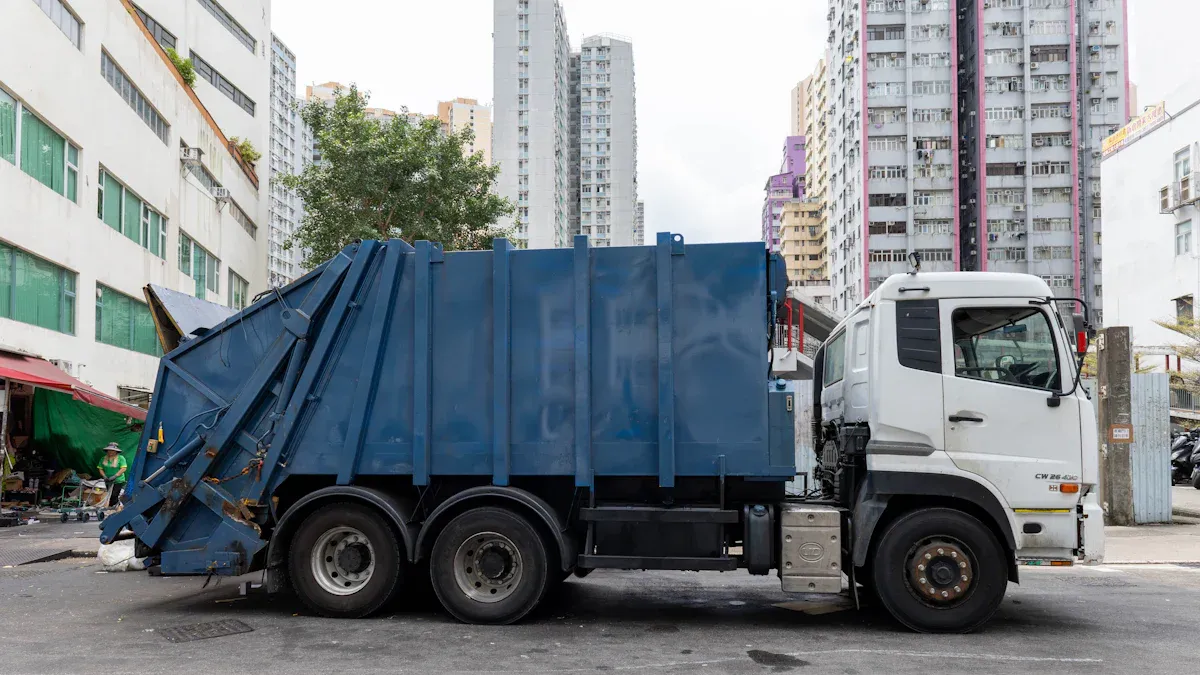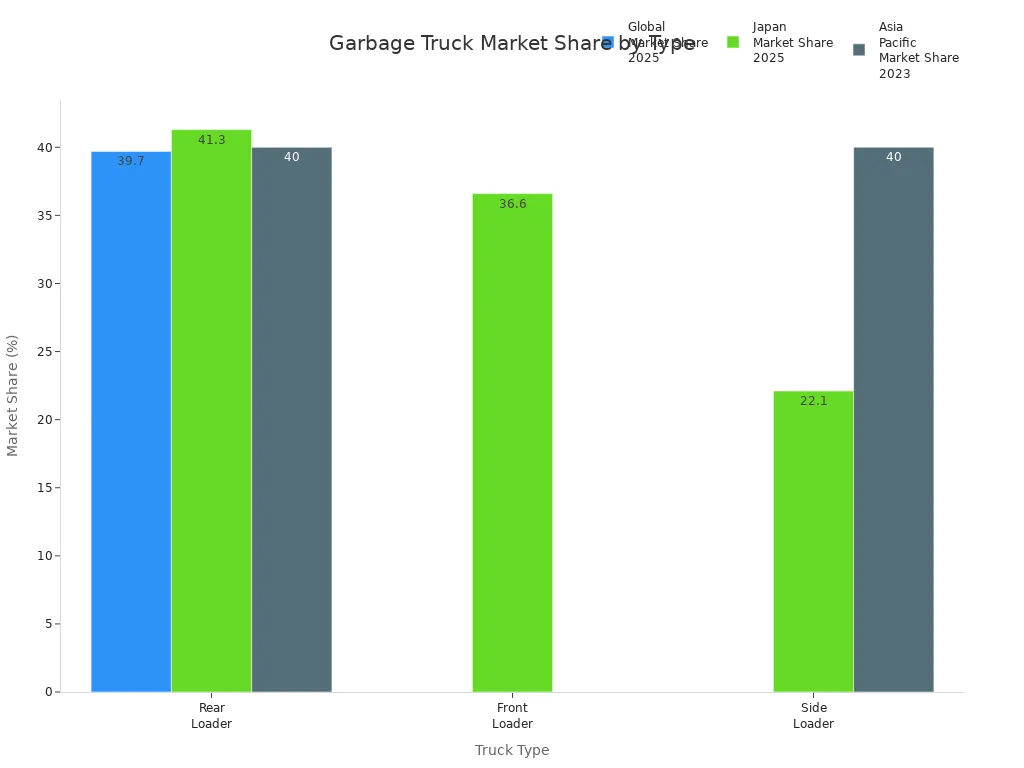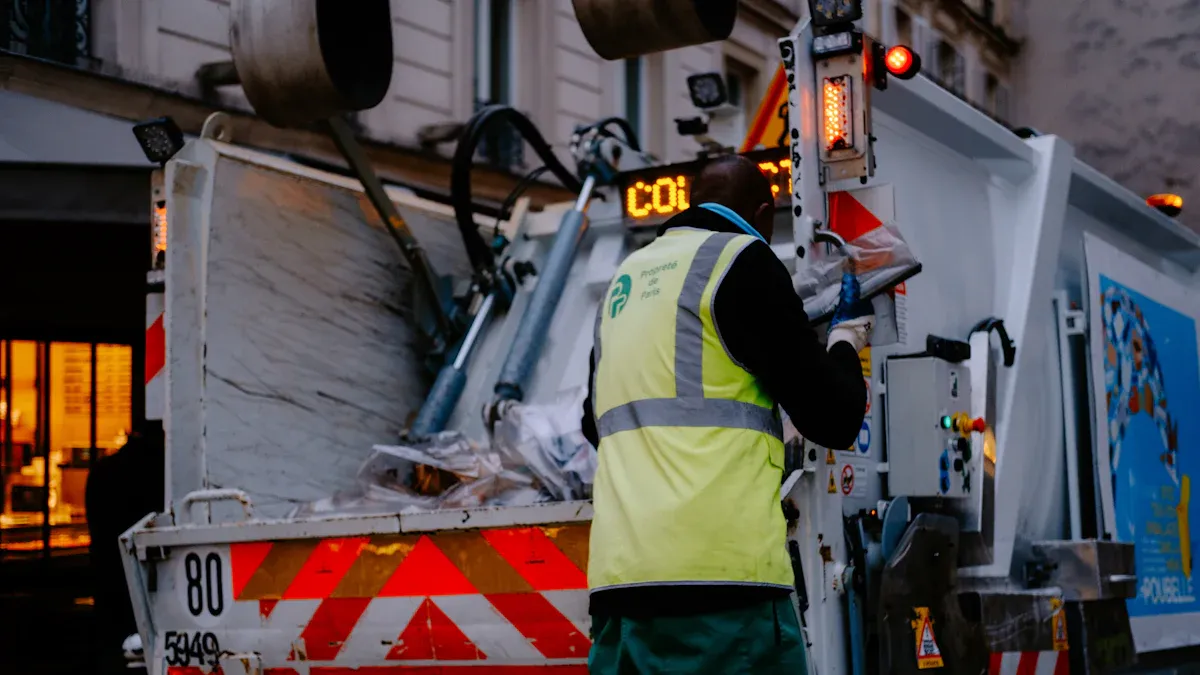


What Is a Garbage Truck and How Does It Work
Views: 0 Author: Site Editor Publish Time: 2025-08-08 Origin: Site









A garbage truck picks up and moves trash from homes, businesses, or streets to a place where it gets thrown away. These trucks are important for waste management. They make collecting trash quicker, safer, and easier. Here are some cool facts about garbage trucks:
Modern garbage trucks have smart sensors, GPS, and automation. These features help save fuel and make things safer.
New garbage truck designs help lower pollution and noise. They also help keep neighborhoods cleaner.
These facts show why garbage trucks are important for your town and the earth.
Key Takeaways
Garbage trucks have different types. These include rear loaders, front loaders, and side loaders. Each type is made for a special trash job.
New garbage trucks use smart technology. They also use hydraulic systems and compaction. This helps them carry more trash safely. It also means fewer trips to landfills.
Safety features help workers stay safe. These features include cameras, sensors, and emergency controls. They make trash collection easier and safer.
Eco-drive technology and cleaner engines help trucks use less fuel. They also lower pollution. This keeps cities cleaner.
Sorting trash the right way is important. Recycling and using the right garbage truck help waste management. These steps also protect the environment.
Garbage Truck Types

There are different garbage trucks for different jobs. Each type is made for a special use in waste collection. Some trucks are for homes, some for businesses, and some for factories. Here are the main types of garbage trucks you should know:
Rear Loader
Rear loaders work for both homes and businesses. You often see them in neighborhoods and on city streets. Workers put trash in the back of the truck. The truck has a lift that dumps the bins. Rear loaders can take many kinds of bins. They can pick up trash from over 800 homes in one day. These trucks are the most common in the world. In Asia Pacific, they make up about 40% of all garbage trucks. People like them because they can crush big items and carry heavy trash.
Front Loader
Front loaders are best for picking up trash from businesses. You see them at shopping malls, warehouses, and big offices. The truck has forks that lift big dumpsters over the front. It empties the trash into a large bin on the truck. This design lets the truck lift heavy loads and hold a lot of trash. Front loaders help workers do less lifting. They also fit well in small spaces. You find them mostly in business and factory areas.
Side Loader
Side loaders are great for picking up trash from homes, especially in busy cities. There are two main kinds: manual and automated side loaders. Automated side loaders have a robotic arm. The driver controls the arm to grab and empty bins fast. This saves time and means fewer workers are needed. Side loaders are becoming more popular in places like China and India. These cities need quick and easy trash pickup. CJQC’s HOWO 20M⊃3; automated side loader uses smart tools like AI and odor control. This makes it good for crowded neighborhoods.
Specialty Models
Some garbage trucks do special jobs. Roll-off trucks move big open bins with bulky or building waste. They use arms or cables to load and unload heavy bins. Other special trucks, like CJQC’s HOWO 116HP, can keep smells in and have strong bodies for tough jobs. You see these trucks in factories or recycling centers.
Tip: Picking the right garbage truck helps you collect more trash faster and keeps your town cleaner.
Here is a table that shows the main types of garbage trucks and what they do:
Garbage Truck Type | Primary Applications | Key Features and Uses |
|---|---|---|
Rear Loader | Residential, Commercial | Manual/semi-automated loading, high capacity, versatile |
Front Loader | Commercial, Industrial | Hydraulic forks, large dumpsters, single operator |
Side Loader | Residential | Mechanical/robotic arm, fast, single operator |
Roll-Off Trucks | Commercial, Industrial, Bulky | Large containers, hydraulic/cable loading, not for homes |

CJQC sells many kinds of garbage trucks. These include automated side loaders and compression trucks. Their trucks use new technology to work better and help the environment. You can trust CJQC for smart ways to collect trash from homes and businesses.
Key Features
Compaction System
The compaction system is very important in a garbage truck. It lets the truck hold more trash by pressing it tightly together. CJQC’s Intelligent Compaction System uses two hydraulic cylinders and smart technology. This system can make trash six times smaller. The truck can carry more waste and needs fewer trips. The hopper is made of strong steel and holds trash before it gets pressed. The packer blade moves the trash into the truck and squeezes it. This helps keep your neighborhood clean and saves time.
Tip: A good compaction system means you drive to the landfill less and use less fuel.
Hydraulic Mechanisms
Hydraulic mechanisms help many parts of a garbage truck work. They lift heavy bins, move the compaction blade, and dump trash. The system has cylinders, pumps, valves, and hoses. These parts work together to make strong force. Hydraulics help you load, press, and unload trash quickly and safely. New hydraulic technology, like telescopic cylinders, saves energy and works better. Taking care of these systems stops breakdowns and keeps your truck working well.
Safety and Controls
Safety features and controls keep you safe and make work easier. New garbage trucks have cameras all around, emergency stop buttons, and comfy cabs. You get computer controls to watch how things work in real time. Robotic arms and sensors mean you do less hard work and stay safer. Trucks have systems to keep them steady when loading trash. Rear cameras and lane warnings help you avoid crashes. These features help you work safely and get more done.
Common safety features:
Systems that help avoid crashes
Electronic stability control
Self-driving technology
Seat belts and airbags
Eco-Drive Technology
Eco-drive technology helps you use less fuel and pollute less. CJQC’s Eco-Drive system saves energy and shuts off the engine when not needed. This can cut fuel use by up to 22%. You can pick trucks with CNG or LNG engines for cleaner air. Driving smoothly and braking gently also saves fuel and lowers pollution. Studies show these tools can cut fuel costs and greenhouse gases by 7% or more. Odor control systems keep the air around your truck smelling fresh.
Note: Eco-drive technology helps keep cities clean and meets tough environmental rules.
How Garbage Trucks Work

Collection Process
You collect trash by driving along a set route. Before starting, you check your truck to see if it works. You also make sure you know what kind of waste to pick up. You use controls to lift bins or dumpsters. Hydraulic arms or forks help lift heavy containers easily. Rear loaders let you put trash in the back. Front loaders use forks to lift big dumpsters over the cab. Side loaders have a robotic arm that grabs bins from the curb. Automated systems help you collect trash faster and safer. This means you spend less time at each stop.
Tip: Route optimization software helps you find the fastest way to collect trash. This saves fuel and cuts down on time spent driving.
Here is a simple step-by-step way to collect trash with a garbage truck:
Check your truck and confirm your route.
Use hydraulic arms or forks to lift bins or dumpsters.
Dump waste into the hopper or main compartment.
Turn on the compaction system if you need to.
Go to the next place to collect trash.
Modern garbage trucks have cameras and sensors. They also use fleet management systems to track how well you are doing. You can watch your progress live and change your route if needed.
Compaction
After loading waste into the hopper, you use the compaction system. This system presses the trash together tightly. A metal blade powered by hydraulics squeezes the trash. This makes the waste take up less space. Your garbage truck can carry more before unloading. Compaction means you make fewer trips to the landfill. This saves fuel and lowers pollution.
Compaction presses waste into a tight mass. This makes it easier to move.
Hydraulic systems use strong pressure to keep the load stable and stop spills.
You save money and work better by carrying more waste each trip.
CJQC’s Intelligent Compaction System uses two hydraulic stages and smart technology. It can make trash six times smaller. You can collect more trash and keep your area cleaner with fewer trips.
Note: Compaction lets you carry more and helps stop smells and spills while driving.
Transport and Dumping
After collecting and compacting trash, you drive to a disposal site. You move the waste safely and make sure nothing spills. At the landfill, recycling center, or transfer station, you use hydraulic plates or arms to unload trash. Some trucks dump waste right onto the ground. Others move it to bigger vehicles for the last trip.
Here is a normal way to transport and dump trash:
Drive to the right disposal site.
Park your garbage truck for unloading.
Use hydraulic systems to push or lift waste out.
Sort and process waste if you need to.
Clean your truck and get ready for the next round.
Modern trucks help you use less fuel and make less pollution. You can use eco-friendly engines and smart routes to help the environment. After dumping, you clean your truck to stop health problems and keep it working well.
Reminder: Good transport and dumping keep your town safe and help with better waste management.
After Collection
When a garbage truck picks up your trash, the waste’s journey is not over. You may wonder what happens after collection. The next step depends on the kind of waste and how your city handles trash. Most waste goes to landfills, recycling centers, or waste-to-energy plants.
Landfill
Landfills are the main way to get rid of solid waste. In the United States, about 38% of city waste goes to landfills. Around the world, 37% of waste is put in landfills. Of this, 8% goes to sanitary landfills, and 31% goes to open dumps. In India, more than 70% of waste ends up on land. Landfills work by pressing and covering trash with dirt. New landfills use liners to stop dirty water from getting into the ground. But landfills can hurt the environment:
Methane gas forms when food and plants break down without air.
Methane is a strong greenhouse gas, much worse than carbon dioxide.
Many landfills do not have systems to catch methane, so it leaks out.
Trucks that move trash to landfills make more carbon emissions.
Making landfills bigger can destroy animal homes and hurt nature.

Recycling
Recycling helps keep more trash out of landfills. In the U.S., about 30% of waste is recycled, but we could recycle even more. Some cities make companies recycle up to 80% of their trash. The most recycled things are paper, yard waste, plastics, metals, and glass. These items go to special centers. There, people and machines sort and get them ready to use again.
Material Category | Percentage of MSW Composition | Recycling Rate / Recovery Rate |
|---|---|---|
Paper and Paperboard | 27% | Newspapers/mechanical papers ~67% |
Yard Trimmings and Food | 28% | Yard trimmings ~60% |
Plastics | 13% | N/A |
Metals | 9% | N/A |
Rubber, Leather, Textiles | 9% | N/A |
Wood | 6% | N/A |
Glass | 5% | N/A |
Waste-to-Energy
Waste-to-energy plants are another way to handle trash. In the U.S., about 15% of city waste goes to these plants. Here, trash is burned to make electricity or heat. This means less waste goes to landfills and less methane is made. These plants give steady energy, which helps cities with little space for landfills. But building these plants costs a lot and needs good pollution controls. Ash and smoke must be handled to keep the air and land clean.
Tip: If you sort your trash and recycle more, you help use landfills less and make waste management cleaner.
You help keep your town clean every day. Garbage trucks pick up and press trash together. This makes your area safer and healthier. New trucks have smart sensors and use less fuel. They also help the air by making less pollution.
Smart tools help sort recycling and use landfills less. They also make picking up trash faster.
Automated systems and live tracking make work safer. They also help save money.
Community Action | Result |
|---|---|
Learn about recycling | More waste gets reused |
Join clean-up events | Cleaner parks and streets |
When you help with better waste plans, you make the future cleaner for all.
FAQ
What types of waste can garbage trucks collect?
Garbage trucks can pick up many kinds of waste. They collect trash from homes and yards. They also take recyclables and big items. Some trucks can carry special waste like building debris or factory materials. You should check your city’s rules before putting out trash.
How do automated side loaders work?
Automated side loaders have a robotic arm for bins. The driver controls the arm from inside the truck. The arm grabs, lifts, and empties the bin fast. It puts the bin back in place after. This system saves time and needs fewer workers.
Why is compaction important in garbage trucks?
Compaction helps the truck hold more waste. The system squeezes trash together tightly. This means you make fewer trips to dump sites. You use less fuel and make less pollution. Compaction also stops spills and bad smells in your area.
Are garbage trucks environmentally friendly?
Many new garbage trucks use eco-drive systems. Some trucks run on CNG or LNG engines. These trucks use less fuel and make less pollution. Some also have systems to control bad smells. These features help keep the air clean and protect nature.
What safety features do modern garbage trucks have?
Modern garbage trucks have cameras and sensors for safety. They also have emergency stop buttons and real-time alerts. These tools help stop accidents and keep workers safe. Some trucks have lane warnings and stability systems for extra safety.
Tip: Always follow safety rules when using a garbage truck.






